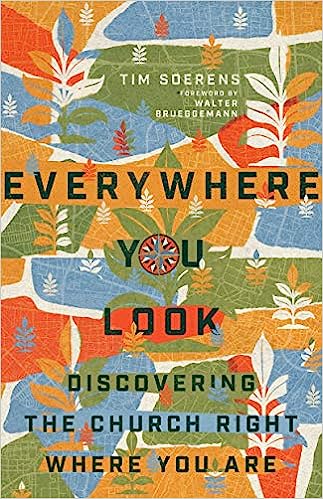This Tuesday, we are continuing our discussion of Tim Sorens’s book, Everywhere You Look: Discovering the Church Right Where You Are. For this Tuesday, please read Chapter 2 “The Big Why.” On p.27, Sorens references a TED-X talk given by Simon Sinek entitled “How Great Leaders Inspire Action.” Please watch his 18:30-minute talk HERE. Mr. Sinek’s three concentric circles will guide our discussion this week.
The Big Why:
Sinek begins his talk by asking the question: “How do you explain when others are able to achieve things that seem to defy all assumptions?” He looks at three positive case studies – Apple, the Wright Brothers, and Martin Luther King – and one negative case study – TiVo. His answer to his initial question is “People do not buy what you do, they buy why you do it.” @5:35 To illustrate his point, he comes up with three concentric circles – the inner circle is Why, the middle circle is How, and the outer circle is What. Those who focus on the Why, are the great leaders because they inspire everyone else.
He says that most organizations understand What they do, some know How they do what they do, but few understand Why they do what they do. An organization that understands Why they do what they do will not only be successful but will drive the marketplace. An organization that only understands What they do will be lucky to hold on past the next business cycle. @ 2:50
A successful organization will do business with people who believe what they believe. They will hire employees who believe what they believe, not people who simply need a job. With these ingredients, he says, any organization will be successful. The example he uses is the Wright Brothers vs. Samuel Pierpont Langley. Langley had the money for capital and labor, he had government backing, and he had great publicity, but he only knew the What not the Why. @8:45.
Apple: (@4:00)
Think about Apple. Apple could say – “What: We make great computers. How: They are beautifully designed, simple to use, and user-friendly. Want to buy one?” Meh. But Apple does say – “Why: Everything we do, we believe in challenging the status quo. We believe in thinking differently. How: By making products that are beautifully designed, simple to use, and user-friendly. What: We make computers (and a lot of other stuff).” No one wants to buy an MP3 player or a phone from a computer company – IBM, Dell, etc. – but they do from Apple.
TiVo: (@13:40)
Sinek’s negative example is TiVo. When TiVo came out it told you what it did: pauses and rewinds live TV, skips commercials, and memorizes viewing habits. It only talked about What it does. As a result, its IPO was a flop and it eventually got bought out. Sinek’s question is what if TiVo had focused on the Why of its product, not the What? The Why would be something like “If you are a person who would like total control over every aspect of your life, we have a product for you.”
Martin Luther King: (@15:22)
Senek ends his talk with the example of Martin Luther King. There were other great orators in the mid-20th century and others who dedicated their lives to civil rights, but there was only one Martin Luther King. King’s central message was not so much to tell people what specifics needed to change and how, but to tell them what he believed. King spoke about Why, not What. People who believed what King believed, took his cause and made it their own, and went out and told other people to believe as well. People did not come to Washington on August 28, 1963, to support King. They came to Washington because of what they believed, and of their shared belief with Dr. King. Dr. King said “I Have a Dream” not “I Have a Plan.” Read the speech. It lacks concrete legislative policies that people can get lost in and have disagreements about. It is only about beliefs – that all men are created equal, that blacks and whites can sit down at a table together as brothers, that children will judged by the content of their character and not the color of their skin, etc. King was successful because he spoke about the Why.
Conclusion: (@17:30)
Senak concludes his talk with these observations. First, we follow those people and institutions that lead, not because we have to but because we want to. Second, we follow those that lead, not for themselves, but for ourselves. We are following a vision that we share with them. Finally, those who start with “Why” have the ability to inspire (literally, to fill with the spirit) those around them.
Please take the time to watch Mr. Senak’s talk. As he goes through his talk, continuously ask yourself the “Why” of the church. Not what we do (we have really great music). Not how we do it (have you seen our choir/praise band/etc). But why do we do it?
Dinner is at 6. The menu is BBQ Chicken. Discussion about 6:45. Compline at 8. Hope to see you here.
The mission of the Church is to restore all people to unity with God and to each other in Christ Jesus. 1979 BCP 855


Pingback: Everywhere You Look, Chapter 3: The Magic of Paying Attention, pt.1 – Ancient Anglican